A group is a military unit or a military formation that is most often associated with military aviation.

Naval Air Station Lemoore or NAS Lemoore is a United States Navy base, located in Kings County and Fresno County, California, United States. Lemoore Station, a census-designated place, is located inside the base's borders.

Marine Aircraft Group 11 is a United States Marine Corps aviation unit based at Marine Corps Air Station Miramar that is currently composed of two F-35C squadrons, one F-35B squadron, two F/A-18C squadrons, one fleet replacement squadron, one KC-130J tactical aerial refueling squadron, a maintenance and logistics squadron, and a wing support squadron. They fall under the command of the 3rd Marine Aircraft Wing and the I Marine Expeditionary Force.

Marine Attack Squadron 231 (VMA-231) is a United States Marine Corps fixed wing attack squadron that consists of AV-8B Harrier (V/STOL) jets. The squadron, known as the "Ace of Spades", is based at Marine Corps Air Station Cherry Point, North Carolina and fall under the command of Marine Aircraft Group 14 (MAG-14) and the 2nd Marine Aircraft Wing.

Marine Fighter Attack Squadron 142 (VMFA-142) was an aviation unit of the United States Marine Corps Reserve that was active from 1942 to 2008. At the time of its inactivation, the squadron was based at Naval Air Station Atlanta, Georgia and fell under the command of Marine Aircraft Group 42 (MAG-42), 4th Marine Aircraft Wing. Due to a re-organization within Marine aviation, the squadron moved to Naval Air Station Fort Worth Joint Reserve Base, Texas and was placed in a cadre status under Marine Aircraft Group 41.

Marine Aircraft Group 41 (MAG-41) is a United States Marine Corps reserve aviation unit based at Naval Air Station Joint Reserve Base Fort Worth, Texas that is currently composed of one F/A-18C squadron, one KC-130J squadron, one C-40 squadron, one Northrop F-5 aggressor squadron based at Marine Corps Air Station Yuma, Arizona, one Marine Light Attack Helicopter Squadron at MCAS Camp Pendleton, one MV-22B squadron based at MCAS Miramar, one aviation logistics squadron and two wing support squadrons with multiple detachments throughout the United States.

Marine Aircraft Group 32 (MAG-32) was a United States Marine Corps aviation unit established during World War II.
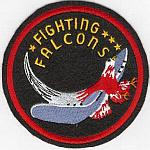
Marine Fighting Squadron 221 (VMF-221) was a reserve fighter squadron of the United States Marine Corps. Originally commissioned during the World War II, it flew the Brewster F2A-3, and after reconstitution in 1943, the F4U Corsair. The squadron, also known as the "Fighting Falcons", is most notable for its actions on 4 June 1942, during the Battle of Midway, which resulted in 23 members of the squadron, many posthumously, being awarded the Navy Cross for their actions in combat. VMF-221 ended World War II with 185 air-to-air victories, the second most of any Marine Fighting Squadron in the war.
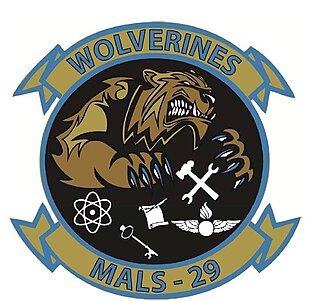
Marine Aviation Logistics Squadron 29 (MALS-29) is an aviation logistics support unit of the United States Marine Corps. Known as the "Wolverines", they fall under the command of Marine Aircraft Group 29 and the 2nd Marine Aircraft Wing and are currently based at Marine Corps Air Station New River. MALS 29 supports multiple types of aircraft and provides detachments to aviation combat elements operating globally in support the United States National Defense Strategy.

Marine Aircraft Group 49 is a United States Marine Corps Reserve aviation unit based at Joint Base McGuire–Dix–Lakehurst, New Jersey that is currently composed of squadrons that fly the MV-22B, CH-53E, AH-1Z, UH-1Y, UC-35D and UC-12F/W aircraft as well as an Aviation Logistics Squadron and Wing Support Squadron.
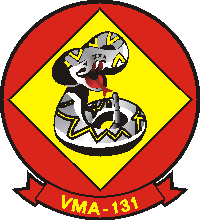
Marine Attack Squadron 131 (VMA-131) was an A-4 Skyhawk attack squadron in the United States Marine Corps. The squadron, also known as the "Diamondbacks", were part of the Marine Forces Reserve and were based at Naval Air Station New York, Brooklyn, New York from 1960 through 1970 and NASJRB Willow Grove from 1971 until their deactivation in 1998.

Strike Fighter Squadron 125 (VFA-125), also known as the "Rough Raiders", is a United States Navy strike fighter squadron based at Naval Air Station Lemoore, California. The "Rough Raiders" are a Fleet Replacement Squadron flying the F-35C Lightning II.

Marine Aviation Training Support Group 22 (MATSG-22) is a United States Marine Corps aviation training group that was originally established during World War II as Marine Aircraft Group 22 (MAG-22). Squadrons from MAG-22, were decimated at the Battle of Midway and, after reconstituting, fought during the Battle of Okinawa. The group was deactivated following the end of the war and was not reactivated until 1 May 2000, when the Marine Aviation Detachment at Naval Air Station Corpus Christi, Texas was renamed MATSG-22.
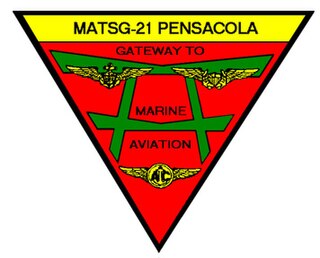
Marine Aviation and Training Support Group 21 (MATSG-21) is a United States Marine Corps aviation training group that was originally established in 1922 as the 2nd Aviation Group. During World War II the unit was known as Marine Aircraft Group 21 (MAG-21). Squadrons from MAG-21 fought in many of the opening battles of the war to include the Battle of Wake Island, Battle of Midway and as part of the Cactus Air Force during the Battle of Guadalcanal. The group was deactivated following the end of the war and was not reactivated until 2000 when the Marine Aviation Detachment at Naval Air Station Pensacola, Florida was renamed MATSG-21. The core of the MATSG personnel is derived from 175 officer instructors and 550 student naval aviators/naval flight officers.
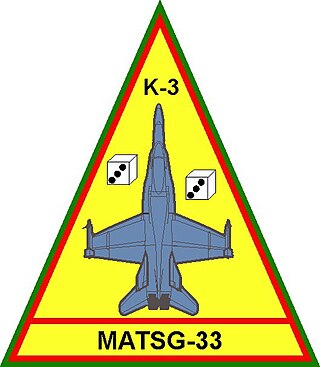
Marine Aviation and Training Support Group 33 (MATSG-33) is a United States Marine Corps aviation training group that was originally established during World War II as Marine Aircraft Group 33 (MAG-33). Fighter squadrons from MAG-33 fought most notably during the Battle of Okinawa and also as the first Marine aviation units to support the Korean War when they arrived as part of the 1st Provisional Marine Brigade. They helped stabilize the United Nations positions during the Battle of Pusan Perimeter and fought in Korea for the remainder of the war. At some point in the 1960s, the group was deactivated and was not reactivated until 2000, when Marine Aviation Training Support Group at Naval Air Station Oceana, Virginia was renamed MATSG-33.

The United States Marine Corps Aviation (USMCA) is the aircraft arm of the United States Marine Corps. Aviation units within the Marine Corps are assigned to support the Marine Air-Ground Task Force, as the aviation combat element, by providing six functions: assault support, antiair warfare, close air support, electronic warfare, control of aircraft and missiles, and aerial reconnaissance. The Corps operates rotary-wing, tiltrotor, and fixed-wing aircraft mainly to provide transport and close air support to its ground forces. Other aircraft types are also used in a variety of support and special-purpose roles. All Marine Corps aviation falls under the influence of the Deputy Commandant for Aviation, whose job is to advise the Commandant of the Marine Corps in all matters relating to aviation, especially acquisition of new assets, conversions of current aircraft, maintenance, operation, and command.
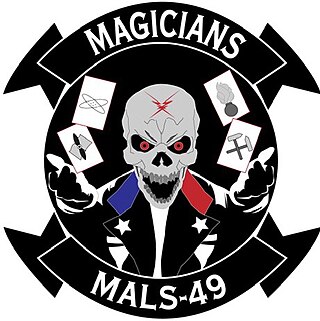
Marine Aviation Logistics Squadron 49 (MALS-49) is a reserve aviation logistics support unit of the United States Marine Corps. They are currently based at Stewart Air National Guard Base in Newburgh, New York and fall under the command of Marine Aircraft Group 49 (MAG-49) and the 4th Marine Aircraft Wing. The squadron 49 is the only MALS in the 4th MAW with an active duty core of maintenance and aviation supply personnel. MALS-49 is currently structured with six separate and distinct divisions of maintenance, supporting three separate and distinct sites, along with five flying squadrons.

Richard C. Mangrum was a United States Marine Corps lieutenant general who served as Assistant Commandant of the Marine Corps from 1965 to 1967. Mangrum was a Marine Corps aviator who was awarded the Navy Cross and the Distinguished Flying Cross for his actions during the Guadalcanal Campaign in World War II.

Marine Attack Squadron 236 (VMF-236) was an attack squadron in the Marine Corps Reserve. The squadron, also known as the "Black Panthers", was part of the Marine Forces Reserve for a short time following World War II and were based at Naval Air Station Anacostia, Washington, D.C. until their decommissioningt. Originally established during World War II, the squadron fought in the Pacific War most notably during the Bougainville Campaign and the campaign to liberate the Philippines. The squadron conducted the first dive bombing attack against Bougainville and was credited with downing 4 Japanese aircraft during the course of the war. VMSB-236 was discommissioned on 1 August 1945 at Mindanao, Philippines two weeks before the surrender of Japan The unit was reactivated as part of the reserves but were again deactivated in the late 1960s. No other Marine Corps squadron has carried VMA-236's lineage and honors since that time.



















